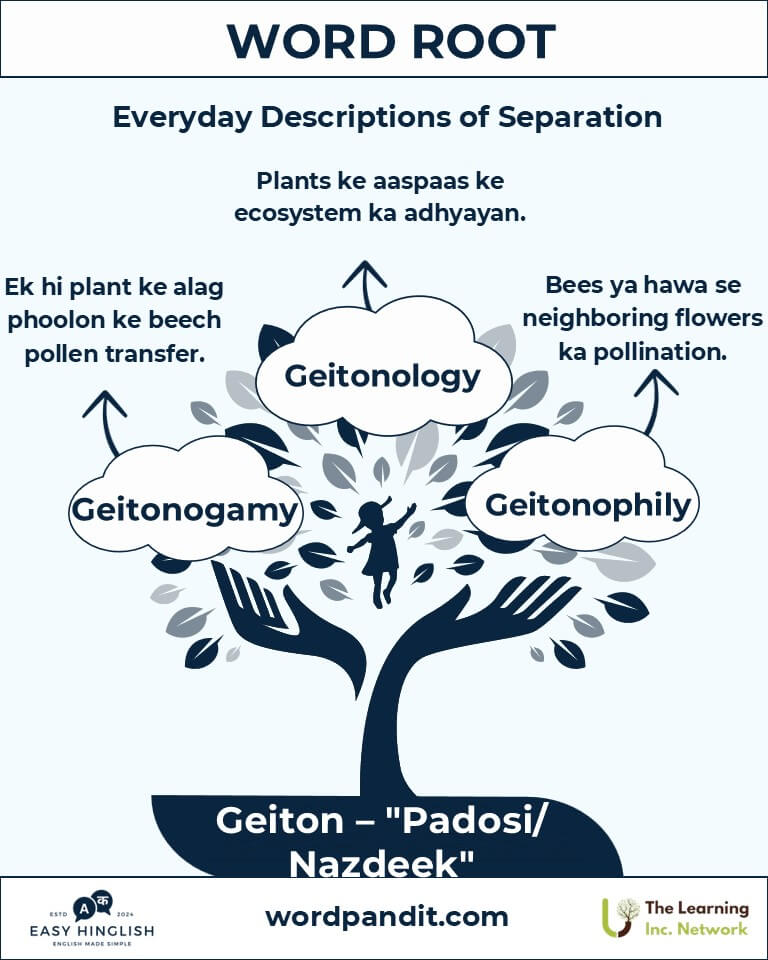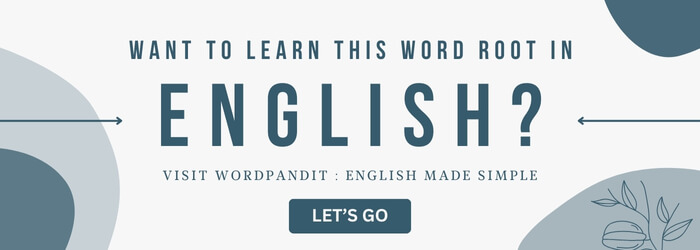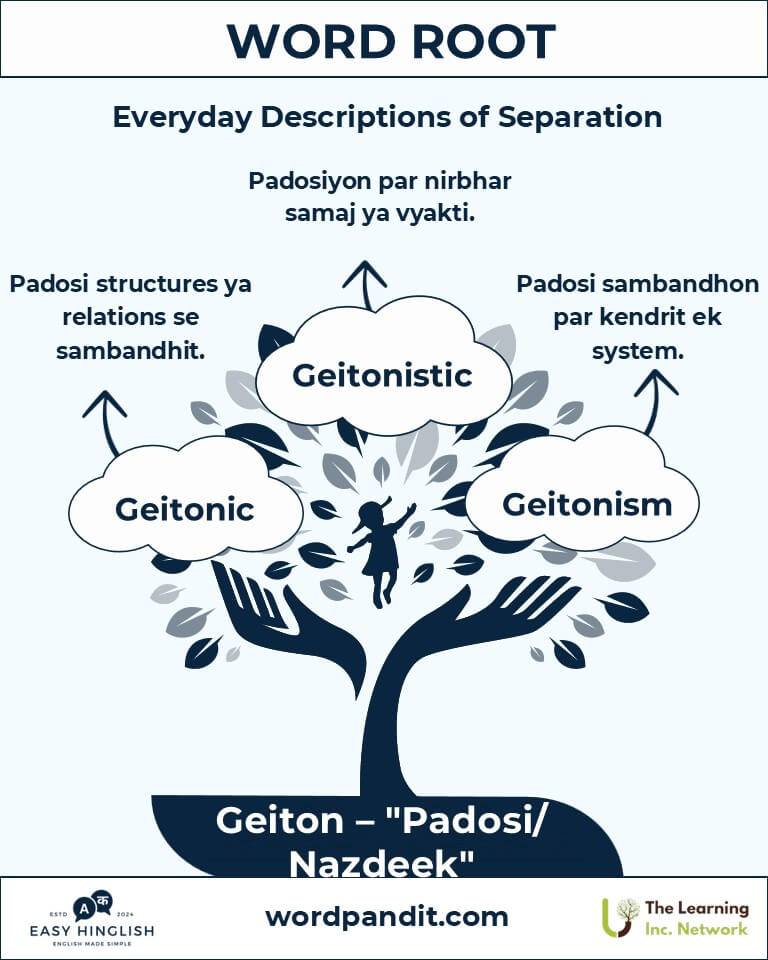Geiton: The Neighborly Root in Nature and Words
(Geiton: प्रकृति और शब्दों में पड़ोसी का मूल)

Table of Contents
- Introduction: The Neighborly Essence of Geiton
- Etymology and Historical Journey
- Mnemonic: Unlocking the Power of Geiton
- Common Geiton-Related Terms
- Geiton Through Time
- Geiton in Specialized Fields
- Illustrative Story: Geiton in Action
- Cultural Significance of the Geiton Root
- The Geiton Family Tree
- FAQs About the Geiton Word Root
- Test Your Knowledge: Geiton Mastery Quiz
- Conclusion: The Living Legacy of Geiton
Introduction: The Neighborly Essence of Geiton
(गाइटन का मूल अर्थ)
Imagine a society where every individual relies on their neighbors. The Greek root "geiton" (गाइटन), meaning "neighbor" (पड़ोसी), captures this essence. This word is used in both social and biological contexts, emphasizing the importance of proximity and mutual influence.

Etymology and Historical Journey
(गाइटन की उत्पत्ति और इतिहास)
The root "Geiton" comes from the Greek word γείτων (geiton), meaning "neighbor" or "one who is nearby." It was used in classical Greek literature both literally and metaphorically. Today, its primary use is in botany, where it describes interactions between neighboring plants and flowers.
Mnemonic: Unlocking the Power of Geiton
(Mnemonic के ज़रिये गाइटन को याद रखें)
Imagine a garden full of flowers, each leaning toward the other, symbolizing the close relationship between neighbors.
Mnemonic Device:
"Geiton is the garden of neighbors, where every flower relies on the one next to it."
Common Geiton-Related Terms
(गाइटन से जुड़े आम शब्द और उनके अर्थ)
- Geitonogamy: The transfer of pollen between flowers of the same plant.
Example: "Geitonogamy allows self-pollination within a plant, mimicking cross-pollination." - Geitonophily: Pollination of neighboring flowers through bees or other agents.
Example: "Geitonophily enhances genetic diversity and is facilitated by bees."
Geiton Through Time
(समय के साथ गाइटन का सफर)
- Ancient Roots: In classical Greek literature, "geiton" referred to literal neighbors or adjacent landholders, depicting cooperation and disputes.
- Scientific Contexts: In botany, geitonogamy explains how flowers within the same plant act as "neighbors" in pollination processes.
Geiton in Specialized Fields
(खास क्षेत्रों में गाइटन का उपयोग)
- Botany: The study of geitonogamy and geitonophily helps ensure crop biodiversity and reproductive strategies.
- Ecology: Pollinators such as bees support the interaction between neighboring plants.
- Sociology: In urban studies, "geiton" metaphorically represents human neighbors and their shared resources and networks.
Illustrative Story: Geiton in Action
(एक कहानी जो गाइटन का महत्व दिखाती है)
In a lush meadow, bees move from flower to flower, collecting nectar and unknowingly facilitating geitonogamy and geitonophily. This natural interplay shows how the relationship between neighbors, whether in nature or human communities, is essential for growth and survival.
Cultural Significance of the Geiton Root
(गाइटन का सांस्कृतिक महत्व)
Ancient Greek poets used "geiton" to depict neighborly relationships and conflicts. In modern societies, it reflects interconnectedness and collaboration in both human and ecological communities.

The Geiton Family Tree
(गाइटन परिवार के संबंधित शब्द)
- Para- (Greek: beside - पास में):
- Parallel: Two lines that run side by side.
- Parasitism: One organism relying on another, often at its expense.
- Proxim- (Latin: near - नज़दीक):
- Proximity: Closeness in space or time.
- Approximate: Close but not exact.
- Sym- (Greek: together - साथ):
- Symbiosis: A close living arrangement where both organisms benefit.
- Symbolic: Representing a shared meaning.

FAQs About the Geiton Word Root
(गाइटन से जुड़े सवाल और जवाब)
Q: What does "Geiton" mean, and what is its origin?
A: "Geiton" means "neighbor" and comes from the Greek word γείτων, meaning "one who is nearby." It is commonly used in botany to describe interactions between neighboring plants or flowers.
Q: What is Geitonogamy, and why is it important in botany?
A: Geitonogamy refers to the transfer of pollen between different flowers of the same plant. While it mimics cross-pollination, it does not increase genetic diversity.
Q: What is the difference between Geitonogamy and Geitonophily?
• Geitonogamy: Pollen transfer within the same plant, leading to self-pollination.
• Geitonophily: Pollen transfer between neighboring flowers, often facilitated by external agents like bees and wind, promoting genetic diversity.
Q: Besides botany, where else is the concept of Geiton used?
A: The concept of "Geiton" is also used metaphorically in sociology and urban studies to describe human neighbor relationships, resource-sharing, and community interactions.
Q: How does Geitonophily support ecosystems?
A: Geitonophily helps transfer pollen between plants, ensuring genetic diversity and strengthening ecosystem stability.
Q: How does Geitonogamy affect crop production?
A: Geitonogamy helps optimize self-pollination strategies in crops, especially in isolated conditions where external pollinators are scarce.
Q: What is the cultural or metaphorical significance of "Geiton"?
A: "Geiton" symbolizes proximity, collaboration, and interconnectedness, emphasizing the importance of neighborly relationships in both natural and human communities.
Quiz About the Geiton Word Root
1. What does "Geiton" mean?
2. What is the term for pollination within the same plant?
3. What role do bees play in Geitonophily?
4. What does Geitonophily focus on?
5. In which field is "Geiton" used metaphorically?
Conclusion: The Living Legacy of Geiton
(गाइटन की जीवंत विरासत)
"Geiton" bridges the natural and human worlds, highlighting the importance of neighbors for survival and growth. Whether in plant pollination, urban communities, or ecological stability, its legacy continues to impact various fields.








